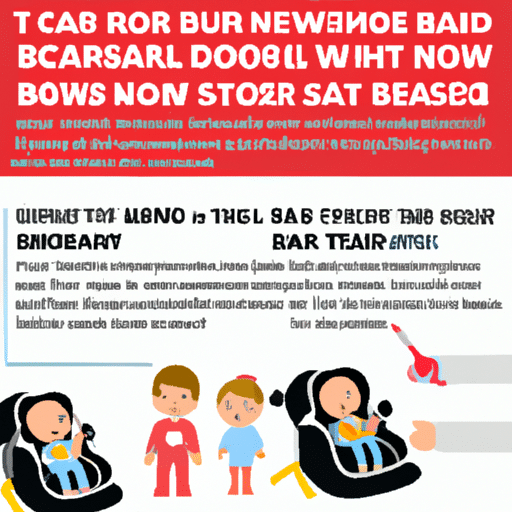Installing a baby car seat with a seatbelt can feel like a daunting task, but rest assured, it doesn’t have to be! In this article, you will discover a step-by-step guide on how to properly install a baby car seat using just a seatbelt. We’ll walk you through the process, ensuring that your little one rides safely and securely in the car. From adjusting the seat to fitting it snugly, you’ll be equipped with all the knowledge you need to confidently install a baby car seat with a seatbelt.

Gather the Necessary Information
Installing a baby car seat with a seatbelt requires some essential information and careful attention to detail. Before you begin, make sure to gather the necessary information. This will help ensure a safe and secure installation for your little one.
Check the Car Seat’s Manual
The first step in installing a baby car seat with a seatbelt is to thoroughly read the car seat’s manual. The manual will provide you with detailed instructions on how to properly install the seat and the specific requirements for your particular model. It is crucial to follow the manufacturer’s guidelines to ensure the seat is installed correctly and safely.
Identify the Seat Belt Type
Next, it is important to identify the type of seat belt in your vehicle. There are two main types of seat belts: lap belts and lap/shoulder belts. Lap belts are typically found in older vehicles, while lap/shoulder belts are more common in newer models. Knowing the type of seat belt in your vehicle will help you understand how to properly thread the belt through the car seat and buckle it securely.
Consult Local Regulations
Before you proceed with the installation, it is crucial to consult local regulations regarding child car seat installation. Each country and even local municipalities may have specific laws and guidelines that must be followed. Familiarize yourself with these regulations to ensure full compliance and the safety of your child. Additionally, it is essential to periodically check for updates to these regulations as they may change over time.
Prepare for Installation
Now that you have gathered the necessary information, it’s time to prepare for the installation of the baby car seat. Taking the necessary steps to prepare will help ensure a smooth and secure installation process.
Choose the Right Position for the Car Seat
Selecting the right position for the car seat is crucial for your baby’s safety and comfort. The back seat is generally the safest place for a car seat installation. Choose a spot where the car seat will have a secure fit and will not obstruct the driver’s visibility. Avoid placing the car seat in the front seat, especially if the vehicle has airbags, as this can pose a serious risk to your child’s safety.
Remove Any Obstructions
Before installing the car seat, take a moment to carefully inspect the surrounding area and remove any obstructions. This includes items such as loose car seat covers, toys, or any other objects that may impede the installation process. Clearing the area will allow you to properly secure the car seat, minimizing any potential hazards or interference.
Clean the Seat and Belts
It is important to ensure that both the car seat and the seat belts are clean before installation. Wipe down the car seat with a mild soap solution and a clean cloth, following the manufacturer’s instructions for cleaning. Additionally, check the seat belts for any dirt, crumbs, or debris that may have collected over time. A clean and well-maintained car seat and seat belts will provide a safer and more secure environment for your child.
Secure the Car Seat
Now that you have prepared for installation, it’s time to secure the baby car seat in your vehicle. Following these steps will help ensure a proper and secure installation.
Position the Car Seat on the Vehicle Seat
Place the car seat on the selected vehicle seat, ensuring a snug and secure fit. The base of the car seat should be in full contact with the vehicle seat, with no overhang. Positioning the car seat correctly is crucial for its stability and effectiveness during a potential accident.
Thread the Seat Belt Through the Slots
Refer to the car seat’s manual for specific instructions on how to properly thread the seat belt through the designated slots. This step may vary depending on the car seat model. Pay close attention to ensuring that the seat belt is correctly threaded and properly secured in the designated fasteners.
Buckle the Seat Belt
Once the seat belt is properly threaded, buckle it securely. Double-check that the buckle is fully engaged to ensure a safe installation. It is important to follow the specific instructions provided by the car seat manufacturer when buckling the seat belt, as different models may have varying requirements.
Remove Excess Slack
After buckling the seat belt, carefully remove any excess slack from the belt. It is crucial to eliminate any looseness or sagging in the installation to ensure the car seat remains secure. Firmly pull on the seat belt, removing any extra slack, while still ensuring that the belt is not overly tight or cutting into the car seat.
Check the Installation
Once the car seat is securely installed, it is vital to perform thorough checks to ensure its stability and effectiveness. Follow these steps to ensure a proper installation:
Perform the Inch Test
Performing an inch test is an essential step in checking the car seat’s installation. Grab the car seat near the belt path and firmly attempt to move it side-to-side and forward and backward. The car seat should not move more than one inch in any direction. If the seat moves significantly, the installation may be insecure, and adjustments need to be made.
Check for a Secure Fit
Ensure that the car seat is securely and snuggly fitted against the vehicle seat. There should be no noticeable gaps or spaces between the car seat and the vehicle seat. A secure fit is crucial for preventing any potential movement or shifting of the car seat during travel.
Check for Movement
Give the car seat a gentle shake to check for any movement. It should be firmly in place, without any wobbling or shifting. If you notice any excessive movement, double-check the installation and make any necessary adjustments to ensure a secure fit.
Verify Proper Belt Positioning
Confirm that the seat belt is correctly positioned on the car seat. It should be threaded through the designated slots and secured tightly. The belt should not be twisted or tangled and should be positioned snugly against the car seat’s frame. Proper belt positioning is essential for the car seat’s stability and effectiveness.

Ensure Proper Harness Adjustment
Properly adjusting the harness is crucial to ensure your child’s safety and comfort while traveling. Follow these guidelines to ensure a proper harness adjustment:
Position the Harness Straps
Position the harness straps on your child’s shoulders, making sure they are neither too high nor too low. The straps should lie flat against the child’s body without any twisting. Adjust the height of the shoulder straps according to your child’s size and the recommendations provided by the car seat manufacturer.
Check Harness Buckle Position
Check that the harness buckle is in the correct position. The buckle should be centered on your child’s chest, resting at armpit level. Ensure that the buckle is properly secured and that all parts are securely locked in place.
Secure and Tighten the Harness
After positioning the harness straps and ensuring the correct buckle position, secure and tighten the harness. The harness straps should be snug against your child’s chest and shoulders, without being too tight or restrictive. Ensure that you can fit no more than one or two fingers between the harness straps and your child’s body.
Double-Check Installation and Security
Even after following all the necessary steps, it is important to double-check the installation and security of the car seat. Taking these additional measures will provide an extra layer of safety for your child:
Confirm Proper Recline Angle
Verify that the car seat is reclined at the correct angle. Most car seats have indicators or level lines that help ensure the proper recline angle. Follow the manufacturer’s guidelines to adjust the seat’s recline properly. This is crucial for your child’s safety and comfort during the journey.
Recheck All Installation Steps
Take a few moments to recheck all the installation steps you followed throughout the process. Ensure that the car seat is properly positioned, the seat belt is correctly threaded, and the harness is secured and adjusted appropriately. This thorough recheck will help identify any potential mistakes or oversights.
Ensure the Seat Is Secure and Snug
Make sure to verify that the car seat is securely and snugly installed, with no excessive movement or play. Apply firm pressure to the car seat from different angles to ensure it stays firmly in place. Ensuring the seat is safe and secure will provide peace of mind throughout your journey.

Understand the Common Mistakes
To further enhance the safety of your child, it is important to be aware of common mistakes made during car seat installations. Understanding these pitfalls will help you avoid them and ensure the utmost safety for your little one:
Using a Damaged or Expired Car Seat
One common mistake is using a damaged or expired car seat. Car seats have an expiration date, after which they may lose their effectiveness and safety features. Additionally, if a car seat has been involved in an accident or has visible damage, it should not be used. Regularly inspect your car seat for any signs of wear or damage and replace it if needed.
Incorrectly Routing the Seat Belt
Improperly routing the seat belt through the car seat is another common mistake. Make sure to read the car seat’s manual and follow the manufacturer’s instructions for correctly threading the seat belt through the designated slots. Incorrect routing can compromise the car seat’s stability and effectiveness.
Failing to Secure and Tighten the Seat Belt
Not properly securing and tightening the seat belt is a critical error that can have serious consequences. It is essential to buckle the seat belt securely and remove any slack. A loose or improperly fastened seat belt can cause the car seat to move or shift during travel, putting your child’s safety at risk.
Seek Professional Help if Needed
If you are unsure about the installation process or have any doubts about the security of the car seat, it is highly recommended to seek professional help. Certified Child Passenger Safety Technicians are experts in car seat installation and can provide guidance and assistance to ensure your child’s safety.
Contact a Certified Child Passenger Safety Technician
Reach out to a Certified Child Passenger Safety Technician in your area for personalized help with car seat installation. They have undergone specialized training and can help you navigate the proper installation and adjustment of your baby’s car seat. They will ensure that the seat is correctly installed and provide you with valuable knowledge on car seat safety.
Attend a Car Seat Installation Inspection Event
Another option is attending a car seat installation inspection event, often hosted by local law enforcement or community organizations. These events allow you to have your car seat installation inspected by experts, ensuring it is done correctly. They can also provide valuable tips and answer any questions you may have regarding car seat safety.

Follow-Up Checks
Installing a baby car seat with a seatbelt is not a one-time task. Regular follow-up checks are essential to maintain the safety and effectiveness of the installation. Make it a habit to perform these checks:
Regularly Inspect the Car Seat and Seat Belt
Regularly inspect the car seat and seat belt for any signs of wear, damage, or degradation. Look for frayed straps, loose connections, or any other issues that may compromise the car seat’s safety. Additionally, check the seat belt for any twists, tears, or signs of weakness.
Educate Yourself on Updates and Recalls
Stay informed about any updates, changes, or recalls related to your car seat model. Manufacturers may issue updates or recalls to address potential safety concerns. Keeping yourself informed will ensure that your baby car seat remains up to date with the latest safety features and guidelines.
By following these comprehensive steps and guidelines, you can confidently install a baby car seat with a seatbelt. Remember, prioritizing your child’s safety is of utmost importance, and proper installation is key to ensuring a safe and secure ride.





